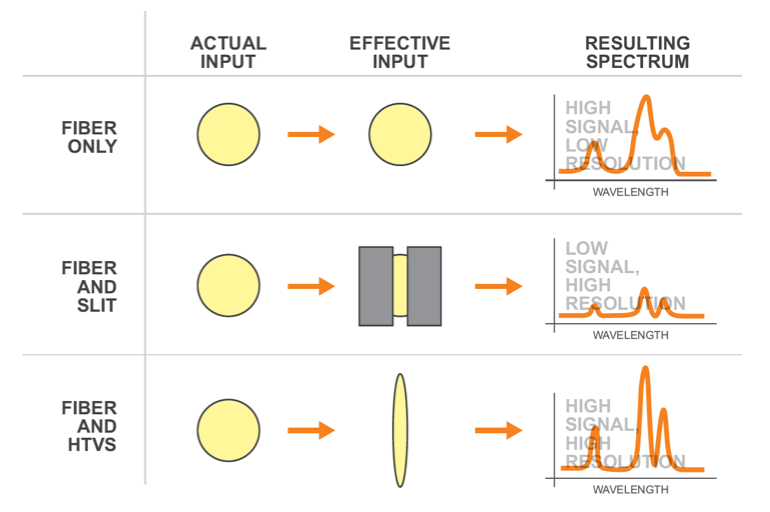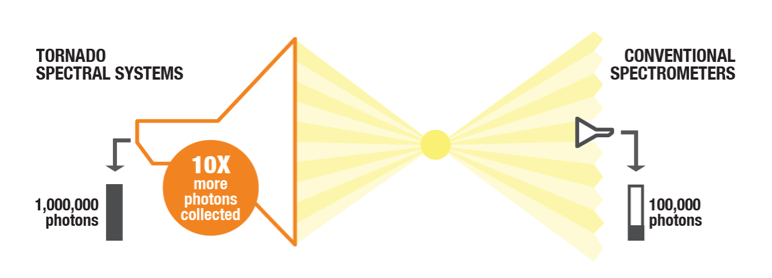Turbocharging Raman Measurements with High-Throughput Virtual Slit Spectrometers
Shaun Fraser, Shamus Driver, and Mark S. Kemper
Introdution
Although Raman spectroscopy is a powerful and flexible analytical tool, Raman signals are usually quite weak – for most molecules fewer than one Raman scattered photon is generated from one million incident laser photons – so spectrometer efficiency (sensitivity) is of utmost importance. Furthermore, Raman spectral bands are often both narrow and closely spaced. Traditional slit spectrometers require a very narrow input slit to achieve high spectral resolution and therefore have poor optical throughput, limiting their effectiveness in low light level scenarios like Raman spectroscopy. A spectrometer design that incorporates Tornado’s HTVS™ (High-Throughput Virtual Slit) technology avoids this trade-off between sensitivity and spectral resolution and thus enhances overall system performance, making measurement of weak Raman signals a practical reality.
A Raman measurement that is intended for quantification needs to be fast, accurate and precise, encapsulating the best possible resolution in both wavelength and intensity. The far-reaching benefits of this information-rich technique can only be fully unleashed with the highest performance spectrometers. With an order of magnitude improvement in efficiency over conventional slit spectrometers, HTVS technology allows Tornado Raman analyzers to achieve 10x faster measurements for rapid chemical reactions and 3x or better improvement in LOD (limit of detection) for more precise measurement.
Dispersive Spectrometers and Optical Resolution Versus Throughput
A spectrometer captures broadband light through an entrance aperture, directs the beam on to a diffraction grating, and focuses the spectrally diffracted beams onto a detector array. When designing a typical dispersive spectrometer, the optical engineer must balance the system-level requirements for wavelength range, spectral resolution, and system sensitivity. The main optical elements that define these parameters are the entrance slit, diffraction grating, detector, and optics for collimating and focusing the light.
Generally, spectral resolution is directly related to the slit width, with a narrower slit providing a proportionately sharper spectral image and thus better spectral resolution. In some conventional spectrometers the slit rejects as much as 75% to 95% of the light entering the spectrometer in order to achieve the spectral resolution required for a demanding application like Raman spectroscopy. But with fewer photons being detected, the inherent uncertainty in signal intensity will increase and the measurement accuracy and sensitivity will suffer. Some sort of resolution vs sensitivity trade-off is therefore required, resulting in unfavorable compromises and limiting the full measurement potential of the spectrometer.

FIGURE 1: The comparison among HTVS, slit, and no slit
The High-Throughput Virtual Slit (HTVS™) is a technological innovation in the field of optical spectroscopy that overcomes the trade-off between optical throughput and spectral resolution faced by traditional dispersive slit spectrometers (please see Figure 1). In an HTVS spectrometer, the physical input slit is replaced by a “virtual slit”, a configuration of internal optical elements which efficiently reformats the input source into a slit-like shape without the large efficiency losses typical with a narrow physical slit. As can be seen in Figure 2, the HTVS technology allows the spectrometer to collect 10 times more photons than the previous state-of-the-art equipment. Although applicable to many different spectroscopic modalities, the HTVS concept has been found to be particularly powerful in the design and function of Raman spectrometers for chemical quantification, where better analyzer sensitivity often makes the difference in whether the application requirements can be successfully achieved or not.

FIGURE 2: Capturing 10x more photons with Tornado’s HTVS technology
How HTVS Technology Overcomes The Resolution-Throughput Trade off
The bottom-line benefit to the user of a spectrometer with an HTVS design is increased signalto- noise without sacrifice of spectral resolution. Tornado’s enhanced photon management technology provides the possibility for:

faster analyses where speed of measurement is required

better limits of detection where sensitivity is at a premium

high-quality measurements where laser power limitations are imposed because of safety/regulatory reasons (such as ATEX-limited areas)

comparatively reduced errors of measurement allowing upgraded quantitative resolution
This performance advantage means that HTVS-enabled spectroscopy is able to enhance the information output for nearly any application, allowing better decision-making regarding the process. HTVS even makes some applications feasible that were not possible to accomplish with conventional spectrometers.
Summary
HTVS technology allows the best process Raman analysis currently achievable anywhere. Combined with their small size and low cost, Tornado’s non-destructive, real-time measurement solutions offer numerous benefits for established analytical practice and facilitate broader adoption of Raman methods for pharmaceutical, petrochemical, food, biotech, and other applications.



